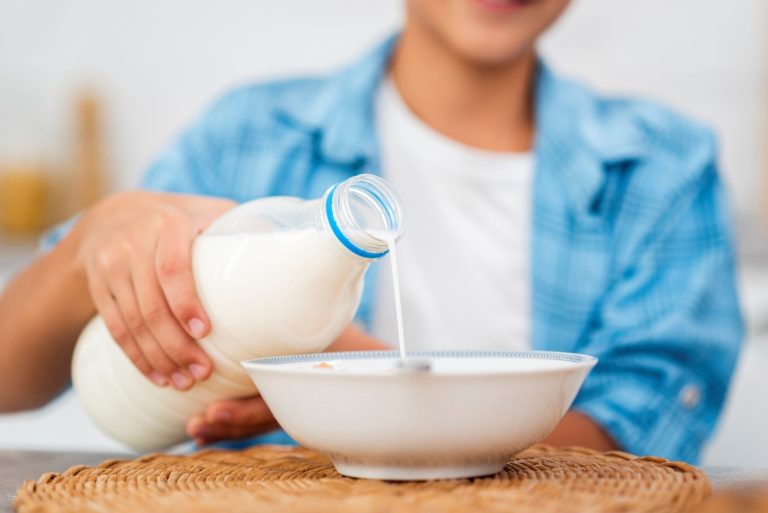Lactose Intolerance in Children - What to Do

Introduction
If you have ever noticed your child experiencing tummy troubles after enjoying their favorite treats, you may wonder, “Could it be lactose intolerance?”. Lactose intolerance in children can be genuinely concerning and may impact their daily lives and overall well-being. The symptoms can leave your child feeling uncomfortable, irritable, and socially self-conscious.
Understanding this condition is key to keeping our children happy and healthy. Let us dive into the world of lactose intolerance in children and learn what you can do to help your child.
Understanding Lactose Intolerance
Causes of Lactose Intolerance

- Lactase Production Naturally Declines with Age: This is the most common form of lactose intolerance. As a child grows, lactase production naturally decreases, making it more challenging to digest lactose.
- Underlying Medical Conditions: Conditions that damage the small intestine, like celiac disease, inflammatory bowel disease, or intestinal infections, can lead to lactase deficiency. Successful treatment of the underlying condition may resolve lactose intolerance symptoms
- Genetic Defect: In rare cases, children are born with a genetic defect preventing the small intestine from producing lactase from the start. This type of lactose intolerance can manifest in infancy and will require specialised care.
Risk Factors for Lactose Intolerance
Certain factors can increase a child’s likelihood of being lactose intolerant:
- Family History: A family history of lactose intolerance raises the chances of a child developing the condition
- Ethnic Background: Lactose intolerance is more prevalent in individuals of Asian, African, Hispanic, or Native American descent. Genetics may contribute to this condition
- Underlying Medical Conditions: Children with specific digestive system conditions, such as Crohn’s disease, ulcerative colitis, and irritable bowel syndrome, face a higher risk of developing lactose intolerance
- Infections: Gastrointestinal infections, caused by certain bacteria or viruses, can temporarily injure the small intestine lining, leading to temporary lactose intolerance.
Signs and Symptoms of Lactose Intolerance
Wondering if your little one might be experiencing lactose intolerance? Look out for these signs and symptoms which typically manifest within a few hours after consuming lactose-containing foods and can vary in severity:

- Abdominal Pain: Children may experience cramping and discomfort in the abdominal region, ranging from mild to severe and lasting for hours
- Diarrhoea: Frequent loose stools are a common symptom of lactose intolerance. Usually lactose intolerance is correlated with intake and will not lead to dehydration. Babies can have multiple explosive stools per day
- Bloating: The abdomen may feel distended or bloated, causing discomfort and a sense of fullness
- Gassiness: Increased flatulence is typical, leading to excessive passing of gas
- Nausea: Some children may feel nauseated after consuming lactose-containing foods, with more severe cases leading to vomiting.
Diagnosis of Lactose Intolerance
If you suspect your child may have lactose intolerance, consult a paediatrician for an accurate diagnosis. The diagnostic process often involves:
- Medical History: The doctor will inquire about your child’s symptoms, medical history, and any family history of lactose intolerance. Detailed information about dietary habits and symptom onset is crucial for diagnosis
- Physical Examination: A physical examination can help rule out other conditions with similar symptoms. The paediatrician may check for signs of abdominal tenderness or bloating
- Lactose Tolerance Test: This test involves fasting and consuming a lactose-containing beverage after the fast. The doctor monitors your child’s blood glucose levels to assess how well your child is digesting lactose. If lactose is digested well, it will lead to a rise in blood glucose levels, making this test highly effective for diagnosing lactose intolerance
- Hydrogen Breath Test: Another test used to diagnose lactose intolerance is the hydrogen breath test. If there is high levels of undigested lactose, an increase in hydrogen levels will be detected during the test
- Stool Acidity Test: In some cases, especially for infants and young children, a stool acidity test can detect the presence of undigested lactose in the stool. This non-invasive method tests for lactase deficiency in children who cannot undergo other tests.
Differentiating Lactose Intolerance vs. Other Abdominal Conditions
Sometimes, tummy issues can be a bit tricky to unravel. Distinguishing lactose intolerance from other conditions, particularly milk or dairy intolerance, is crucial for an accurate diagnosis. There is a difference between lactose intolerance and milk or dairy intolerance, also known as a milk allergy. While both share some common digestive symptoms, such as abdominal pain and diarrhoea, they are fundamentally different.
In the case of milk or dairy intolerance (milk allergy), the child’s immune system responds to specific milk proteins, such as casein or whey, leading to allergic reactions. Such reactions can include hives, itching, and swelling. In severe cases, it can even lead to anaphylaxis, a life-threatening allergic reaction.
Management Options for Lactose Intolerance in Singapore
In Singapore, there are several ways to help children who are lactose intolerant:

- Opt for Lactose-Free Alternatives: Limit or eliminate lactose-containing foods like milk, cheese, and yoghurt. Choose lactose-free alternatives or lactase-treated products available in local stores. Singapore offers a variety of lactose-free and dairy-free options to cater to dietary needs.
- Lactase Supplements: Over-the-counter lactase supplements can be taken with meals that contain lactose to help digest them better. These supplements can be easily found at pharmacies and can help your child tolerate small amounts of lactose.
- Nutritional Guidance: Consult a registered dietitian about making a personalised diet plan for your child that meets all their nutritional needs without lactose. Dietitians can help those who are on a lactose-free diet find other ways to get the calcium and other nutrients they need.
- Paediatric Support: Experienced paediatricians can provide expert guidance and ongoing care, making sure your child receives the best support. A professional paediatrician can monitor your child’s growth, help meet their nutritional needs, and adjust the treatment plan when required.
Tips for Care and Prevention
While it is not possible to prevent lactose intolerance, you can take steps you can take to manage the condition effectively and enhance your child’s quality of life. Here are some tips:
- Read Labels: Keep an eye on food labels for lactose content while grocery shopping in Singapore. Labels often indicate whether a product is lactose-free or suitable for individuals with lactose intolerance.
- Gradual Introduction: Some children may tolerate small amounts of lactose better, so try introducing lactose-friendly goodies slowly into their diet under the guidance of your paediatrician.
- Regular Follow-Up: Do not forget regular check-ins with your paediatrician to monitor your child’s progress and make necessary adjustments to the treatment plan when needed. Regular follow-up appointments can help track your child’s growth.
Conclusion
Lactose intolerance might present challenges but armed with the right information and a team of experts, your child can still enjoy a tasty and tummy-friendly childhood. If you have questions or concerns, do not hesitate to reach out to SBCC Baby and Child Clinic. Together, we will ensure your little one’s journey is filled with smiles and not stomachaches.









